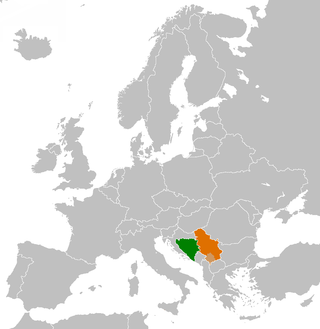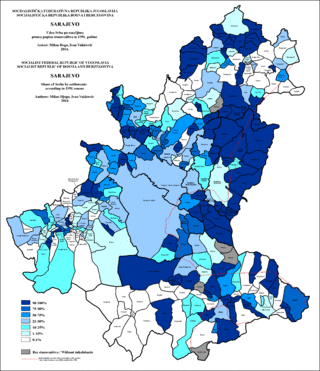
Republika Srpska is one of the two entities of Bosnia and Herzegovina, the other being the Federation of Bosnia and Herzegovina. It is located in the north and east of the country. Its largest city and administrative centre is Banja Luka, lying on the Vrbas river, and with a population of about 138,963 people.

The Bosnian War was an international armed conflict that took place in Bosnia and Herzegovina between 1992 and 1995. The war is commonly seen as having started on 6 April 1992, following a number of earlier violent incidents. The war ended on 14 December 1995 when the Dayton accords were signed. The main belligerents were the forces of the Republic of Bosnia and Herzegovina, the Republic of Herzeg-Bosnia, and the Republika Srpska, the latter two entities being proto-states led and supplied by Croatia and Serbia, respectively.

Zvornik is a city in Republika Srpska, Bosnia and Herzegovina]. In 2013, it had a population of 58,856 inhabitants.

Milorad Dodik is a Bosnian Serb politician serving as the 8th president of Republika Srpska since 2022, having previously served from 2010 to 2018. He also served as the 7th Serb member of the Presidency of Bosnia and Herzegovina from 2018 to 2022.

The Republic of Bosnia and Herzegovina was a state in Southeastern Europe, existing from 1992 to 1995. It is the direct legal predecessor to the modern-day state of Bosnia and Herzegovina.
The Sijekovac killings, also called the Sijekovac massacre, refers to the killing of Serb civilians, in Sijekovac near Bosanski Brod, Bosnia and Herzegovina on 26 March 1992. The assailants were members of Croat and Bosniak army units. The exact number of casualties is unknown. The initial reported number was eleven, while the Republika Srpska authorities listed 47, however, exhumations in Sijekovac carried out for two weeks in 2004 unearthed 58 bodies of victims, of whom 18 were children.

Fudbalski klub Drina Zvornik is a professional association football club from the city of Zvornik that is situated Bosnia and Herzegovina.

The modern-day countries of Bosnia and Herzegovina and Serbia both originated from Yugoslavia. The majority of population in both countries speak one of the standard varieties of Serbo-Croatian and Serbia is one of the largest investors in Bosnia and Herzegovina.

Ethnic cleansing occurred during the Bosnian War (1992–95) as large numbers of Bosnian Muslims (Bosniaks) and Bosnian Croats were forced to flee their homes or were expelled by the Army of Republika Srpska and Serb paramilitaries. Bosniaks and Bosnian Serbs had also been forced to flee or were expelled by Bosnian Croat forces, though on a restricted scale and in lesser numbers. The UN Security Council Final Report (1994) states while Bosniaks also engaged in "grave breaches of the Geneva Conventions and other violations of international humanitarian law", they "have not engaged in "systematic ethnic cleansing"". According to the report, "there is no factual basis for arguing that there is a 'moral equivalence' between the warring factions".

Zvornik Castle, also known as the Old Town of Zvornik and Kula Grad, is a medieval castle located in Zvornik, Bosnia and Herzegovina, on the mountain Mlađevac overlooking Drina Valley. Zvornik fortress is 147 metres (482 ft) above sea level.
Events in the year 2015 in Bosnia and Herzegovina.
Liplje is a mountain village located in the municipality of Zvornik, Bosnia and Herzegovina, neighboring Snagovo. Within Liplje there are 14 settlements: Bajrići, Bećirovići, Čamlija, Hadžići, Husići, Jašići, Jošanica, Kadrići, Korin Brijeg, Liplje, Salihovići, Samari, Sultanovići and Velja Glava.
The Liplje camp was a concentration camp operated between 25 May 1992 and 2 June 1992 by Army of Republika Srpska in the village Liplje near Zvornik during the Bosnian War. It was set up for Bosniak men, women and children, in an effort to ethnically cleanse the area of all non-Serb residents. The Liplje concentration camp was liberated after one week of operation; it is known for being the only camp with Bosniak victims to be liberated during the war.
There has been an increase in incidents involving alleged radical Islamism in the Balkans since the 1990s.
The Bijeli Potok massacre refers to the mass killing of 675 Bosniak civilians by Serbs on 1 June 1992 in the settlement Bijeli Potok within the village Đulići, located in the municipality of Zvornik, Bosnia and Herzegovina. About 675 Bosniak men and boys, from the multiple villages around Zvornik, were separated from their families by Serb forces, and slaughtered within a week at Bijeli Potok and their bodies hidden in mass graves throughout the Drina Valley.
Operation Ruben was a police raid operation targeting what police said were suspected radical Islamists in the Republika Srpska, an entity of Bosnia and Herzegovina. It commenced on 6 May 2015, following an attack on a police station in Zvornik. Several people were arrested a week after the attack.

The Dayton Agreement ended the Bosnian War and created the federal republic of Bosnia and Herzegovina (BiH), which consists of the Bosniak and Croat-inhabited Federation of Bosnia and Herzegovina (FBiH) and the Serb-inhabited Republika Srpska (RS). Although the Bosnian Serbs were viewed as "anti-Dayton" during the first years after the war, since 2000 they have been staunch supporters of the Dayton Agreement and the preservation of RS. Bosniaks generally view RS as illegitimate, and an independence referendum from BiH has been proposed in RS. The 2006 Montenegrin independence referendum and Kosovo's 2008 declaration of independence have raised the possibility of a referendum and unification with Serbia. In 2015, after a judicial and police crisis, the governing Alliance of Independent Social Democrats said that it would hold an independence referendum in 2018 if RS's autonomy was not preserved.
The Skelani massacre refers to the Army of the Republic of Bosnia and Herzegovina (ARBiH) attack on Skelani, group of villages in region of Srebrenica, Bosnia and Herzegovina, held by Army of Republika Srpska (VRS), which happened on 16 January 1993. Between 40-65 Serbs were killed in the attack.

The Exodus of Sarajevo Serbs was the migration of ethnic Serbs from Sarajevo, the capital of Bosnia and Herzegovina, between January and March 1996 after the Dayton Agreement that concluded the Bosnian War (1992–95).
On 12 July 1992, a total of 69 Bosnian Serb soldiers and civilians were killed in the villages of Zalužje and Sase in the municipality of Srebrenica, and Biljača and Zagoni in the municipality of Bratunac, after an attack by the Army of the Republic of Bosnia and Herzegovina (ARBiH). It occurred during the Bosnian War.











